I admit it: I was a little braindead when the time came to think of a topic for January’s roundtable. The thing that immediately came to mind was this: it’s the first of the year. What’s the first thing that you remember that set you on the path to becoming the magnificent speculative fiction fan that you are today? What was the earliest piece of speculative fiction that sparked that special something in your brain? Join us now as we reminisce!
Nicole Taft: When considering this question, I first thought back to television shows when I was a kid. Teenage Mutant Ninja Turtles? David the Gnome? Sure, I liked those things a lot, but were they what set the stage for the nerdy spaz I am today?
I realized after a moment that no, they weren’t. It was my dad. When I was maybe 5 or 6, my dad told me a story about a huge creature called a Balrog and a wizard. The two did battle with one another and then they both fell down a huge hole. “What happened?” I would ask. His reply was always, “I can’t tell you—you’ll have to read the book.”
It was at the same age that my dad read The Hobbit to me. I had an older sister, and for the life of me I can’t remember if he read to both of us or if he just knew that I was (somehow) the geekier of the two and more into what he had to offer. Hobbits, singing dwarves, elves laughing and celebrating in dark woods, and a dragon hoarding his treasure—all of these things fascinated me. For years afterward I would ask my father, hoping to catch him unawares, whatever happened to that wizard that fought the Balrog. But he never faltered and always said that I’d have to read the book.
I didn’t read Lord of the Rings until I was around 20 when my dad came home one day and out of the blue handed it to me. But by then I was a fully-fledged nerdy girl who wrote fantasy and science fiction stories, who loved Dragon Ball Z, and who’d seen Spider-Man in theaters 3 times. And later, when we all saw the first Lord of the Rings in the theater, I was able to finally answer the question my sister asked me: What happened to what wizard who fell down a hole fighting a Balrog?
Spoiler alert: He’s fine.
Nancy O’Toole Meservier: Asking me about the first speculative thing I feel in love with is very challenging, because I don’t think there was a time in my life when I wasn’t consuming speculative content. Before I was old enough to read on my own, my father was telling me fairy tales before bed. I consumed more than my fair share of Disney movies (which we videotaped off the Disney channel), almost all which include some sort magical of fantasy element. And any kind of cartoon that involved a medieval setting- whether it be Gummi Bears, or the Grimm’s Fairy Tale anime, was an auto-watch for me.
But one of the shows I remember especially liking might surprise some people, and not just because this television show, which aired in the 1950s, is way too old for me. In addition, it’s not immediately obvious that it’s a speculative show.
The old black and white Zorro television show, staring a pre-Lost in Space Guy Williams used to air on the Disney channel. Zorro focuses on a young man named Diego De La Vega, who, returning from university in the 1820s, finds his home city of Los Angeles consumed by corruption. Thinking quickly, he choses to keep his finely tuned fencing skills a secret, crafting a persona of a gentlemen of leisure that he hides behind during the day, and a masked crime fighter named Zorro that he will use to fight for justice at night.
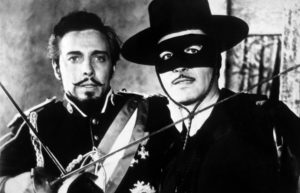
Doesn’t that sound an awful lot like Batman? He even dresses in black and has a servant who knows his true identity (Bernado, who goes the extra mile by pretending to be deaf in order to spy for Diego). And while it’s too early to have a Batmobile, Diego’s black horse (Tornado) can feel almost that impressive that time.
Watching Zorro as a kid totally prepared me for the superhero tropes that I would end up falling in love with during my teen/adult years. Whether it be Diego’s struggles to keep his identity a secret, or the fight and chase scenes that would show up every episode.
I recently re-watched the entire first story arc as an adult, and found that some things held up quite well, especially Diego’s charm, the stunts, and quite a few of the storylines. Other elements could do better. Female characters are constantly being shoved into the background, and the shows portrayal of Native Americans is incredibly cringey. One thing that I am 100% convinced of though is the fact that Zorro was a superhero show, and one that was important to me in my development as a fan of speculative fiction.
 Ronya F. McCool: This is a difficult question! But I think I have to go with classic Star Trek. In the early 1980s, the series was in syndication, and my parents liked to watch the reruns. As a kid, I was fascinated by it. Except for the original Battlestar Galactica, it wasn’t like anything else on television at the time (that I recall). As a 5- or 7- year-old kid I did not grasp all of the moral or ethical quandaries presented by the episodes. I had seen Superman II and some other science fiction and fantasy films in movie theaters, but going to see a movie was an event in itself since we lived in a small town about 30 minutes (depending on who was driving) away from the nearest city. But every Sunday evening the spectacle of science fiction, in the form of the adventures of the Enterprise and its crew, was delivered to our family television (in those days, a giant box that sat on the floor) and we didn’t have to drive anywhere to get it. The transporter was my favorite thing, and I remember reenacting it all the time. A few years ago I rewatched the original series as an adult, and only then did I realize how heavily the series leaned on Greco-Roman mythology, Western civilization, Shakespeare, etc. So many civilizations were modeled after Greece and Rome, and more than a few villains were obsessed with segments of Earth’s history (Trelane, hello!). Also, Kirk’s womanizing ways had gone completely over my head. I’m not sure I even have a favorite episode, but “The Trouble with Tribbles” and “The Doomsday Machine” stick out. I do know it was the most unique, wondrous thing I had ever seen, and it set me up for a lifetime of geeky nerdiness.
Ronya F. McCool: This is a difficult question! But I think I have to go with classic Star Trek. In the early 1980s, the series was in syndication, and my parents liked to watch the reruns. As a kid, I was fascinated by it. Except for the original Battlestar Galactica, it wasn’t like anything else on television at the time (that I recall). As a 5- or 7- year-old kid I did not grasp all of the moral or ethical quandaries presented by the episodes. I had seen Superman II and some other science fiction and fantasy films in movie theaters, but going to see a movie was an event in itself since we lived in a small town about 30 minutes (depending on who was driving) away from the nearest city. But every Sunday evening the spectacle of science fiction, in the form of the adventures of the Enterprise and its crew, was delivered to our family television (in those days, a giant box that sat on the floor) and we didn’t have to drive anywhere to get it. The transporter was my favorite thing, and I remember reenacting it all the time. A few years ago I rewatched the original series as an adult, and only then did I realize how heavily the series leaned on Greco-Roman mythology, Western civilization, Shakespeare, etc. So many civilizations were modeled after Greece and Rome, and more than a few villains were obsessed with segments of Earth’s history (Trelane, hello!). Also, Kirk’s womanizing ways had gone completely over my head. I’m not sure I even have a favorite episode, but “The Trouble with Tribbles” and “The Doomsday Machine” stick out. I do know it was the most unique, wondrous thing I had ever seen, and it set me up for a lifetime of geeky nerdiness.
J.L. Gribble: I can’t point to the one thing that happened first, but I have some scattered memories from late elementary school. I was a military brat growing up, and for fourth and fifth grade, I lived in New Jersey. The speculative fiction life snagged me in a three-pronged attack at about this time, compliments of my mother, stepfather, and grandmother.
The local library had a shelf in the kid’s section dedicated to Newbery Award winners and honorable mentions, and my mom declared that I had to pick one of those books every time we checked books out. My mom was also a voracious reader, so “every time” was two or three visits a month. So many of those books are speculative fiction! From The Voyages of Doctor Doolittle (1923) to The Grey King (1976), I’d found my books. By this point, I wasn’t just wandering the kid’s section. It was about this time that I also developed a voracious appetite for the Dragonlance books and other fantasy.
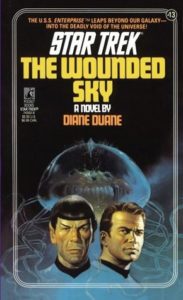 During these years, I also spent one weekend a month at my grandmother’s house. She worked at a paperback exchange as her retirement gig, and I had free run of the store. The kids section was miniscule, so instead Oma introduced me to the wonders of the “Science Fiction” section. There, I found novels about the crew of a fascinating ship called the Enterprise, and its intriguing crew: Kirk, Spock, Uhura, and the rest.
During these years, I also spent one weekend a month at my grandmother’s house. She worked at a paperback exchange as her retirement gig, and I had free run of the store. The kids section was miniscule, so instead Oma introduced me to the wonders of the “Science Fiction” section. There, I found novels about the crew of a fascinating ship called the Enterprise, and its intriguing crew: Kirk, Spock, Uhura, and the rest.
But I wanted more of this Star Trek stuff. Luckily, the nearby Blockbuster video had an entire section of VHS tapes featuring two episodes each of this show. On the Fridays my stepdad and I went to Blockbuster, I read over the episode synopses on the back and made my haphazard way through what I later learned was the first Star Trek series of many. I watched The Next Generation with my parents, and Deep Space Nine began during that time-frame. The crowning glory, however, was when my stepdad brought home copies of a film trilogy borrowed from a friend at work. That Friday evening, I sat down with my parents and watched Star Wars: A New Hope.
I couldn’t wait for my parents to wake up on Saturday morning. I’d watched Empire Strikes Back and Return of the Jedi by lunch time. I re-watched the trilogy at least once more that weekend.
As much as I like to think that I “discovered” speculative fiction all by myself, it’s funny to look back and realize it was all my family’s fault. But I’d rather consider it a gift.
Erin S. Bales: When I was young, my dad and I watched Star Trek: The Next Generation (as well as TOS, whenever we happened across a rerun), and he allowed me to watch a back-to-back airing of Alien and Aliens when I was nine or ten. From there, I developed a bone-deep love of science fiction and horror. I read all of R.L. Stine’s Fear Street books and Christopher Pike’s entire bibliography, eventually moving on to the likes of Stephen King. Around high school, though, things took a turn. I moved away from spec fic and began to read more thrillers, cozy mysteries, chick lit, literary fiction, etc. Basically, realism.
 Why? I’m not sure. I think nineteen-year-old me would have said I’d outgrown genre fiction, but I still loved Star Trek and horror movies and whatnot. Anyway, I denied my love for spec fic for several years. Then, on a whim, I took a course in Children’s Literature. On the syllabus were more than a few books with which I wasn’t familiar, including Sabriel by Garth Nix.
Why? I’m not sure. I think nineteen-year-old me would have said I’d outgrown genre fiction, but I still loved Star Trek and horror movies and whatnot. Anyway, I denied my love for spec fic for several years. Then, on a whim, I took a course in Children’s Literature. On the syllabus were more than a few books with which I wasn’t familiar, including Sabriel by Garth Nix.
There are only two books that I can remember, as an adult, reading and then immediately rereading. The first is Holes by Louis Sachar; the other is Sabriel. I haven’t reread Holes in years, and never saw the movie, but I have reread (or listened to) Sabriel at least once a year since that first double reading. Which means I’ve read it…at least twenty times. God, I’m old.
Regardless, I know Sabriel like the back of my hand. (To a lesser extent, I’m also pretty familiar with Lirael, Abhorsen, and the rest of the stories in the Old Kingdom series.) Sabriel is part of the reason I pursued a master’s in Children’s Lit, which led me to the seminal works of Tamora Pierce, Philip Pullman and others. Sabriel featured in my thesis on feminist themes in YA speculative fiction. It opened me up to countless spec fic books, TV shows, movies, and video games that I may not have experienced. I got another master’s, one that I achieved by writing fantasy and science fiction.
Besides being a wonderful book full of rich characters, interesting magic, and fantastic world-building, Sabriel has led me down so many paths that I may not have otherwise traveled. Ah, but, “Does the walker choose the path, or the path the walker?”
Carey M. Ballard: The Secret of NIMH. Or Mrs. Frisby and The Rats of NIMH, as the book is called, by Robert C. O’Brien. I think this is the first book I read with anthropomorphized characters, and I loved both the movie and the book, even though they are very different (the movie added some supernatural elements). My father scored a movie poster from a video store giveaway, and we hung it in my room; if there had been NIMH toys, I would have been all about them, but the movie was a few years old by the time I saw it.
Mrs. Frisby is a widowed mouse with several mice-children, Teresa (Shannen Doherty!), Martin, and Timothy (pre-TNG Wil Wheaton), and the farm where they live is about to be plowed, putting their home and Timothy in danger. Timothy has pneumonia, and he can’t leave the house. Mrs. Frisby, in her quest to find a solution – heal Timothy or move the house – discovers a secret colony of rats with enhanced intelligence. Products of scientific experiments at a secret lab (based on fact!), the rats can read and write and have increased strength. They agree to help Mrs. Frisby move her house out of the plow’s way. This will involve drugging the farm cat, Dragon – and the only mouse for the job is Mrs. Frisby. She is captured in the attempt – and overhears the humans plotting to exterminate the rat colony on the farm. When she’s rescued, she tells the rats, who help her save her house before relocating their colony.
In the movie, it’s Mrs. Frisby who does the saving (although with the aid of the amulet). But to have a kids’ book and movie follow a mother on a quest was pretty gutsy, I think. Supposedly there is a live-action film in the works, and my normally cynical self looks forward to it, although it’s been “in the works” for years. I keep hoping Elizabeth Banks will be recruited; she’d be perfect to play the voice of Mrs. Frisby. NIMH led me to other books about secret experiments, like House of Stairs by William Sleator, The Bumblebee Flies Anyway by Robert Cormier, Anna to the Infinite Power by Mildred Ames (think Orphan Black), and The Girl With the Silver Eyes, by Willo Davis Roberts.
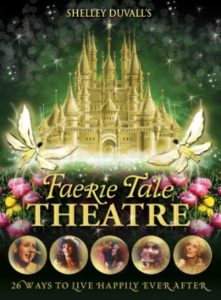
Kristina Elyse Butke: Fairy tales were my first exposure to the fantasy genre and my gateway to speculative fiction. They’ve been a constant presence since childhood, but my earliest memories of fairy tales come from television – three shows in particular: Shelley Duvall’s Faerie Tale Theatre, Jim Henson’s The Storyteller, and Grimm’s Fairy Tale Classics. Let’s hop into the wayback machine for a visit to the late 80s and early 90s!
Faerie Tale Theatre and The Storyteller aired on Disney, but they’re not originally Disney properties (they were made by Showtime and NBC, and Disney picked them up through syndication). While they were similar to Disney works in that they were retelling fairy tales and using celebrities, the commonalities end there. I’d argue these shows are closer to honoring the original spirit of fairy tales – filled with happily ever after, yes, but with elements of sexuality, bawdy humor, and darkness.
Faerie Tale Theatre features stories ranging from famous ones like Beauty and the Beast and Sleeping Beauty, and not-so-familiar tales like The Nightingale, The Princess Who Never Laughed, and The Boy Who Left Home To Find Out About the Shivers, which, by the way, scared the crap out of me as a small child. What I loved about Faerie Tale Theatre was the fact that they embraced the creepiness inherent in a lot of the stories, and in watching the series, I discovered that I actually liked being scared. My gateway to liking horror, too, it seems!
The Storyteller is also unafraid of showing the weirder, darker elements of the original fairy tales. Like Faerie Tale Theatre, famous actors are used to retell the stories, only this time, with puppets aiding in the depiction of fantastical creatures (think more along the lines of the creations of Labyrinth or The Dark Crystal). The Storyteller in particular emphasizes the lesser-known fairy tales like Hans My Hedgehog, The Heartless Giant, and Sapsorrow, which I count among my favorites.
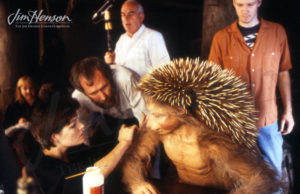
Hair and makeup hard at work creating the costuming for “Hans, My Hedgehog” for The Storyteller
Along similar lines, I watched Nickelodeon’s Grimm’s Fairy Tale Classics to learn about the famous and lesser-known fairy tales, but also to get tastes of the stories before they were bowdlerized by Victorian sensibilities and the Disney machine.
Grimm’s Fairy Tale Classics is a Japanese production by Nippon Animation– so I can count it as one of my first encounters with anime! The series was dubbed in English for Nickelodeon, and had the catchiest theme song ever (which I still remember!), whimsical animation, and of course, some darkness here and there. One of my favorites was “Jorinde and Joringel,” which has stayed with me a looooong time (I can still remember the song the girl-turned-nightingale sings in the forest!).
To this day, as a reader, I gravitate towards stories that reimagine or borrow from fairy tales, and when it comes to my own writing, I tend to embrace fairy tale imagery and motifs (of course, of the darker variety!). These three shows basically imprinted on me, and it’s pretty amazing to see how long-lasting their influence has been.
 Casey Price: I’m fairly certain that it started in second grade. One of my classmates was talking about a book with a vampire bunny. I had a vague idea of what a vampire was (though I’m sure I have no idea how I first learned of the concept), and I was intrigued by the idea of a vampire…bunny. If you don’t already know what I’m talking about, congratulations! I am going to talk to you about Bunnicula! Or, as much as I can remember of it, anyway. Something about this story — a dog and cat, who are forced to welcome a new pet rabbit into the family, and the cat deciding that the rabbit is some kind of vampire — flicked a switch in my still-developing little mind. I devoured Bunnicula (yes, I am so very punny), and two of the sequels: Howliday Inn, and The Celery Stalks at Midnight. This series undoubtedly inspired my love for all things spooky and creepy (not to mention an everlasting fondness for vampire stories). I’m fairly certain it also began my love of the absurd; read the synopsis for The Celery Stalks at Midnight and tell me that it doesn’t sound absolutely, delightfully ridiculous.
Casey Price: I’m fairly certain that it started in second grade. One of my classmates was talking about a book with a vampire bunny. I had a vague idea of what a vampire was (though I’m sure I have no idea how I first learned of the concept), and I was intrigued by the idea of a vampire…bunny. If you don’t already know what I’m talking about, congratulations! I am going to talk to you about Bunnicula! Or, as much as I can remember of it, anyway. Something about this story — a dog and cat, who are forced to welcome a new pet rabbit into the family, and the cat deciding that the rabbit is some kind of vampire — flicked a switch in my still-developing little mind. I devoured Bunnicula (yes, I am so very punny), and two of the sequels: Howliday Inn, and The Celery Stalks at Midnight. This series undoubtedly inspired my love for all things spooky and creepy (not to mention an everlasting fondness for vampire stories). I’m fairly certain it also began my love of the absurd; read the synopsis for The Celery Stalks at Midnight and tell me that it doesn’t sound absolutely, delightfully ridiculous.
I was about the same age when I stumbled upon Scary Stories to Tell in the Dark. I say this as an adult who has experienced more than my fair share of horror over the years: those were some seriously effed-up stories for children to read. The one that genuinely bothers me TO THIS DAY? “Me Tie Doughty Walker.” You can listen to it right here, if you dare. Or read it for yourself. Despite this truly disturbing story, I was hooked. I graduated from the Scary Stories series to the works of R.L Stine (whose work I still love today; give me a Fear Street book, and you will win my everlasting love), Christopher Pike, and their lesser-remembered contemporaries of the 90s teen fiction boom. My fate was sealed, and I became the twisted mess that you know and love. I keep waiting to grow out of this phase, but who knows if that’s ever going to happen. There were other influences in there along the way (Catwings and of course, Labyrinth), but a vampire bunny holds the honor of being the first speculative love of my life.
What was your gateway? Do you remember what set your fabulously speculative life in motion? We want to know!

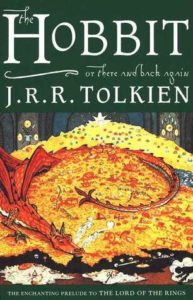



Zorro was an early influence on me, too. There are numerous photos of me wearing my grandmother’s babushkas as capes. I had a plastic sword with a chalk holder tip that you could use to slash a Z or whatever on the sidewalk, sides of buildings, etc. (It didn’t work on cars.) Robin Hood too–they sold whistling arrows, but to hear them, the arrow had to be shot AT you. But as to sf, the Flash Gordon serials were the first, shown two or three per hour on Sunday mornings in Chicago. Also the movie The Seventh Voyage of Sinbad, complete with a dragon and cyclops animated by Ray Harryhausen. There were also the poorly dubbed Hercules movies and various ‘sword & sandal’ epics of the late ’50s and early ’60s.
I couldn’t think of anything good for this Roundtable because to be perfectly honest, I’m not sure I could truly be called a fan of speculative fiction until after I started writing for Speculative Chic. This post did bring back some great memories–I had forgetten about how much I loved Bunnicula and The Secret of NIMH is my all-time favorite children’s movie.
[…] Roundtable: That First Spark […]
I absolutely ADORE Bunnicula. Did you ever get your hands on Nighty-Nightmare? I think there was a Return to Howliday Inn as well. I think. Oh, I loved those books…. I do remember there was an illustrated Christmas Special too!
wizard of Oz and Alice in Wonderland. the Annotated Alice by Martin Gardner Is a work I reread numerous times starting in grade school